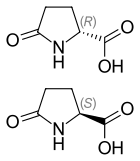Pyroglutamic acid

| |
| Names | |
|---|---|
| Preferred IUPAC name
5-Oxoproline | |
| Systematic IUPAC name
5-Oxopyrrolidine-2-carboxylic acid | |
| Other names
2-Pyrrolidone-5-carboxylic acid
Pidolic acid 5-Oxo-proline | |
| Identifiers | |
3D model (JSmol)
|
|
| 3DMet | |
| Abbreviations | Glp |
| 82134 | |
| ChEBI | |
| ChEMBL | |
| ChemSpider | |
| DrugBank | |
| ECHA InfoCard | 100.005.227 |
| EC Number |
|
| 1473408 | |
| KEGG | |
| MeSH | Pyrrolidonecarboxylic+acid |
PubChem CID
|
|
| RTECS number |
|
| UNII | |
CompTox Dashboard (EPA)
|
|
| |
| |
| Properties | |
| C5H7NO3 | |
| Molar mass | 129.115 g·mol−1 |
| Melting point | 184 °C (363 °F; 457 K) |
| log P | -0.89 |
| Acidity (pKa) | -1.76, 3.48, 12.76 |
| Basicity (pKb) | 15.76, 10.52, 1.24 |
| Isoelectric point | 0.94 |
Except where otherwise noted, data are given for materials in their standard state (at 25 °C [77 °F], 100 kPa).
| |
Pyroglutamic acid (also known as PCA, 5-oxoproline, pidolic acid, or pyroglutamate for its basic form) is an uncommon and little studied amino acid derivative in which the free amino group of glutamic acid or glutamine cyclizes to form a lactam.[1] It is a metabolite in the glutathione cycle that is converted to glutamate by 5-oxoprolinase. Pyroglutamate is found in many proteins including bacteriorhodopsin. N-terminal glutamic acid and glutamine residues can spontaneously cyclize to become pyroglutamate. This is one of several forms of blocked N-terminals which present a problem for N-terminal sequencing using Edman chemistry, which requires a free primary amino group not present in pyroglutamic acid. The enzyme pyroglutamate aminopeptidase can restore a free N-terminus by cleaving off the pyroglutamate residue.[2]
Pyroglutamic acid, also known as pidolic acid, exists as two distinct enantiomers:
- (2R) or D which happens to be (+) or d
- (2S) or L which happens to be (–) or l
Metabolism
As first discovered in 1882, pyroglutamic acid can be formed by heating glutamic acid at 180 °C, which results in the loss of a molecule of water. In living cells, it is derived from glutathione through the action of an enzyme, γ-glutamyl cyclotransferase.[1] It may function to store glutamate, but also acts to oppose the action of glutamate including in the brain.[1] It also acts on the cholinergic system in the brain,[3] and Amyloid β containing pyroglutamic acid is increased in Alzheimer's disease and may be involved in the disease process.[4] Levels of pyroglutamic acid in the blood, called 5-oxoprolinuria, can increase following paracetamol overdose or in inborn error of metabolisms, causing an increased level of acidity called a high anion gap metabolic acidosis.[1][5]
Uses
The sodium salt of pyroglutamic acid — known either as sodium pyroglutamate, sodium PCA, or sodium pidolate — is used for dry skin and hair products, as it is a humectant. It has low toxicity and is not a skin irritant, but its use in products is limited by a high price.[6][7]
L-pyroglutamic acid is sold online as a dietary supplement.[8][9]
Magnesium pidolate, the magnesium salt of pyroglutamic acid, is a mineral supplement.
References
- ^ a b c d Kumar, Akhilesh; Bachhawat, Anand K. (January 25, 2012). "Pyroglutamic acid: throwing light on a lightly studied metabolite" (PDF). 102 (2): 208.
{{cite journal}}: Cite journal requires|journal=(help) - ^ Podell, David N.; Abraham, George N. (1978), "A technique for the removal of pyroglutamic acid from the amino terminus of proteins using calf liver pyroglutamate amino peptidase", Biochem. Biophys. Res. Commun., 81 (1): 176–85, doi:10.1016/0006-291X(78)91646-7, PMID 26343.
- ^ Pepeu, Giancarlo; Spignoli, Giacomo (1989). "Nootropic drugs and brain cholinergic mechanisms". Prog Neuropsychopharmacol Biol Psychiatry. 13 (Supplement 1): S77-88.
- ^ Jawhar, S; Wirths, O; Bayer, TA (November 11, 2011). "Pyroglutamate amyloid-β (Aβ): a hatchet man in Alzheimer disease". J Biol Chem. 286 (45): 38825–32. doi:10.1074/jbc.R111.288308.
{{cite journal}}: CS1 maint: unflagged free DOI (link) - ^ Liss, DB; Paden, MS; Schwarz, ES; Mullins, ME (November 2013). "What is the clinical significance of 5-oxoproline (pyroglutamic acid) in high anion gap metabolic acidosis following paracetamol (acetaminophen) exposure?". Clin Toxicol (Phila). 51 (9): 817–27. doi:10.3109/15563650.2013.844822.
- ^ "Hydromol® (Alliance)". British National Formulary. Retrieved December 5, 2015.
- ^ "Alternatives to Glycerine". Glycerine: A Key Cosmetic Ingredient. p. 424.
{{cite book}}: Unknown parameter|editors=ignored (|editor=suggested) (help) - ^ DellaVecchia, Matthew J. (December 2013). "Inaccurate Serelaxin Chemical Structure". Pharmacy and Therapeutics. 38 (12): 763. PMC 3875272.
- ^ McDougall, Jr., Graham J.; Austin-Wells, Vonnette; Zimmerman, Teena (December 2005). "Utility of Nutraceutical Products Marketed for Cognitive and Memory Enhancement". J Holist Nurs. 23 (4): 415–433. doi:10.1177/0898010105280097. PMC 2398696. (table 1)
